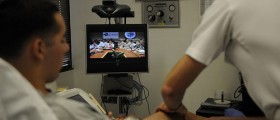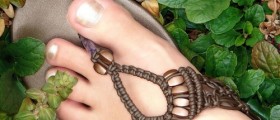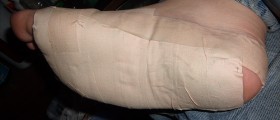
Tinea pedis is infection of the soles of the feet and the space between the toes by some fungi. This condition is also frequently called athlete’s foot or ringworm of the foot. The cause of this foot problem is usually the fungi genus known as Trichophyton, especially the type Trichophyton rubrum (T.rubrum). Tinea pedis can also be caused T.mentagrophytes and Epidermophyton floccosum, as well as T.tonsurans and in some cases Scytalidium dimidiatum, Scytalidium hyalinum and Candida species.
As mentioned, this problems mainly affects the feet, however, it can also spread to other parts of the body or even to the groin. Tinea pedis is very common all over the world and about 70% of all people have had this problem at some point of their life. It more often affects men and the chances to get infected increase with aging. Children very rarely have tinea pedis, while many teenagers experience the symptoms.How Does Fungus Cause Tinea Pedis?
Dermatophyte use the enzymes keratinases to invade the keratin of the skin. Therefore, this infection is strictly limited to keratin layer of the skin. At the same time, Dermatophyte contain substances called mannans, able to slow down immune response of the affected body and also responsible decrease of the sloughing and cause chronic infection.
Invasion of the fungi may be promoted if there are some breaks or maceration of the skin, especially if patients’ immune system is already weakened for some reason. Walking barefoot in public showers or pools is known to be the possible source of Trichophyton infection.Symptoms of Acute Tinea Pedis
Patients suffering from inter-digital (between the toes) tinea pedis suffer from erythema, maceration, scaling and fissuring of the toes, as well as some pruritus. Fourth and fifth toes are most commonly affected with this condition and it can extend to plantar surface of the foot. Sometimes, fungal infection may be accompanied with bacterial infection, which can be more complicated condition.
Inflammatory vesicular tinea pedis causes bullae, filled with fluid or clear and once they burst they leave scaling and erythema. This problem can complicate further with adenopathy, lymphangitis or cellulitis or cause Dermatophytid reaction (hypersensitivity reaction or allergy to infection on the feet).
Ulcerative tinea pedis is often seen in diabetics and immune-compromised patients. Lesions, ulcers and erosions spread rapidly and the condition may become complicated because of some bacterial infection, pyrexia, malaise, lymphangitis and cellulitis.
Additionally, there is chronic hyperkeratotic (or moccasin) tinea pedis. Patients may experience no symptoms or have pruritus, slight scaling and chronic plantar erythema.

















Your thoughts on this
Loading...